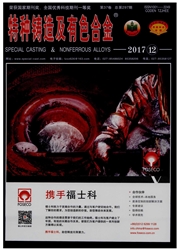

 中文摘要:
中文摘要:
用BaCO3、ZrO2和CaO混合粉料,在1400℃经高温固相反应合成了BaZrO3和CaO掺杂BaZrO3粉料,采用冷等静压结合固相烧结技术,在1750℃烧成BaZrO3和CaO掺杂BaZrO3坩埚,并熔炼Ti2Ni合金,研究了CaO对BaZrO3坩锅微观组织及其与钛合金界面反应的影响。结果表明:掺杂量为15%(摩尔分数)的CaO部分固溶进BaZrO3,坩埚在烧成过程中,过量CaO部分在坩埚内部团聚,阻碍Ba1-xCaxZrO3晶粒的生长,导致坩埚内部出现较大孔洞;另一部分在坩埚壁析出,析出层主要由CaO和Ba1-xCaxZrO3组成,厚度约为70μm。BaZrO3坩埚与钛合金界面反应层厚度约为270μm,而CaO掺杂BaZrO3坩埚与合金并无明显界面反应层。
 英文摘要:
英文摘要:
Abstract: CaO-doped BaZrO3 and BaZrO3 powders were synthesized by a solid-state method at 1 400 ℃ with BaCO3, ZrO2 and CaO powder as starting materials, and subsequently titanium alloys were melted in two crucibles that were prepared with the synthesized powders by cold isostatic pressing and solid-state sintering at 1 750 ℃, respectively. The effect of CaO additive on the microstructure evolution of BaZrO3 crucible and the interracial reaction with titanium alloys was investigated. The results show that a part of CaO salutes into BaZrO3, and the excessive CaO gathers together in sintering process, hindering the sintering of Ba1-xCaxZrO3 grains and resulting in massive big pores in the crucible. A precipitation behavior of CaO in the crucible wall occurs, and this precipitation layer is mainly composed of CaO and Ba1-xCaxZrO3 with the thickness of approximately 70 μm. The erosion thickness of BaZrO3 crucible is 270 μm, and little interfacial reaction between titanium alloys and CaO-doped BaZrO3 crucible occurs.
 同期刊论文项目
同期刊论文项目
 同项目期刊论文
同项目期刊论文
 期刊信息
期刊信息
